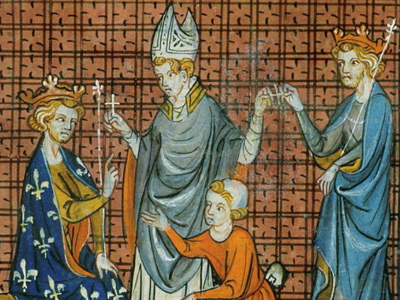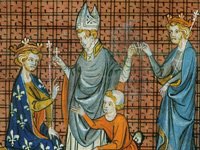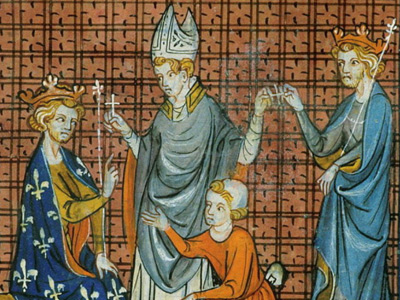Third Crusade (1189–1192)

Siege of Acre
Saladin released King Guy from prison in 1189. Guy attempted to take command of the Christian forces at Tyre, but Conrad of Montferrat held power there after his successful defence of the city from Muslim attacks. Guy turned his attention to the wealthy port of Acre. He amassed an army to besiege the city and received aid from Philip's newly arrived French army. The combined armies were not enough to counter Saladin, however, whose forces besieged the besiegers. In summer 1190, in one of the numerous outbreaks of disease in the camp, Queen Sibylla and her young daughters died. Guy, although only king by right of marriage, endeavoured to retain his crown, although the rightful heir was Sibylla's half-sister Isabella. After a hastily arranged divorce from Humphrey IV of Toron, Isabella was married to Conrad of Montferrat, who claimed the kingship in her name.

During the winter of 1190–91, there were further outbreaks of dysentery and fever, which claimed the lives of Frederick of Swabia, Patriarch Heraclius of Jerusalem, and Theobald V of Blois. When the sailing season began again in spring 1191, Leopold V of Austria arrived and took command of what remained of the imperial forces. Philip of France The Kingdom of France is the historiographical name or umbrella term given to various political entities of France in the medieval and early modern period. It was one of the most powerful states in Europe since the High Middle Ages. It was also an early colonial power, with possessions around the world. Colonial conflicts with Great Britain led to the loss of much of its North American holdings by 1763. The Kingdom of France adopted a written constitution in 1791, but the Kingdom was abolished a year later and replaced with the First French Republic. arrived with his troops from Sicily in May. A neighboring army under Leo II of Cilician Armenia also arrived.
The Kingdom of France is the historiographical name or umbrella term given to various political entities of France in the medieval and early modern period. It was one of the most powerful states in Europe since the High Middle Ages. It was also an early colonial power, with possessions around the world. Colonial conflicts with Great Britain led to the loss of much of its North American holdings by 1763. The Kingdom of France adopted a written constitution in 1791, but the Kingdom was abolished a year later and replaced with the First French Republic. arrived with his troops from Sicily in May. A neighboring army under Leo II of Cilician Armenia also arrived.
Richard arrived at Acre on 8 June 1191 and immediately began supervising the construction of siege weapons to assault the city, which was captured on 12 July. Richard, Philip, and Leopold quarrelled over the spoils of the victory. Richard cast down the German standard from the city, slighting Leopold. In the struggle for the kingship of Jerusalem, Richard supported Guy, while Philip and Leopold supported Conrad, who was related to them both. It was decided that Guy would continue to rule but that Conrad would receive the crown upon his death. Frustrated with Richard (and in Philip's case, in poor health), Philip and Leopold took their armies and left the Holy Land in August. Philip left 10,000 French crusaders and 5,000 silver marks to pay them.
On 18 June 1191, soon after Richard's arrival at Acre, he sent a messenger to Saladin requesting a face to face meeting. Saladin refused, saying that it was customary for kings to meet each other only after a peace treaty had been agreed, and thereafter "it is not seemly for them to make war upon each other". The two therefore never met, although they did exchange gifts and Richard had a number of meetings with Al-Adil, Saladin's brother. Saladin tried to negotiate with Richard for the release of the captured Muslim soldier garrison, which included their women and children. On 20 August, however, Richard thought Saladin had delayed too much and had 2,700 of the Muslim prisoners decapitated in full view of Saladin's army, which tried unsuccessfully to rescue them. Saladin responded by killing all of the Christian prisoners he had captured.
HISTORY

RESOURCES
This article uses material from the Wikipedia article "Third Crusade (1189–1192)", which is released under the Creative Commons Attribution-Share-Alike License 3.0.
© Stories Preschool. All Rights Reserved.






